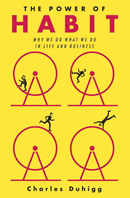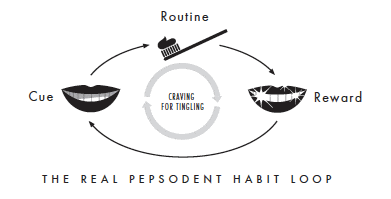 Personal finance in theory is simple. Earn more, spend less. We all know that. But what makes it hard is changing our behavior, and much of that behavior is controlled by habits that we can’t stop. A new book called The Power of Habit: Why We Do What We Do in Life and Business by Charles Duhigg tries to explain the science and behavioral psychology of how habits work. You may have already seen some articles based on his work:
Personal finance in theory is simple. Earn more, spend less. We all know that. But what makes it hard is changing our behavior, and much of that behavior is controlled by habits that we can’t stop. A new book called The Power of Habit: Why We Do What We Do in Life and Business by Charles Duhigg tries to explain the science and behavioral psychology of how habits work. You may have already seen some articles based on his work:
- How Companies Learn Your Secrets (NY Times) – Includes how Target figured out that a man’s teenage daughter was pregnant before he did.
- The Power of Habit (Slate) – An excerpt of the book explores the science of cravings and a habit that almost all of us have: brushing our teeth with toothpaste each morning.
- Book Review in Businessweek – About how a new CEO for Alcoa changed the company by changing their routines.
So how do we change our bad habits so that we are more productive, healthier, and wealthier? We have to understand the Habit Loop, which consists of a cue, the routine itself, and a reward. In the case of toothpaste, the cue is feeling a film over your teeth (or just waking up). The routine is brushing your teeth with toothpaste. The reward is the feeling of a clean mouth, but critically also the tingling feeling from the toothpaste. Even though it doesn’t actually help clean your teeth, without the ingredients that cause the tingling, people don’t feel like toothpaste does it’s job and won’t buy it. We crave the tingling.

Stopping a habit means stopping the habit loop. For example, Duhigg was gaining weight because every afternoon he would go down to the cafeteria and eat a cookie and socialize with friends. After some experimentation, he figured out that the socializing was the reward, and the cookie-eating had just been subconsciously linked. So he started a new habit where he would socialize away from cookies and the craving of snacks went away.
For other bad habits, you may need to avoid the cue, or replace the reward with something that doesn’t harm you as much. I believe this is how nicotine gum and electronic cigarettes work. You can get the nicotine buzz and/or the physical routine of holding a stick and sucking flavored “smoke” out of it.
Starting a new desired habit involves creating a positive reinforcing loop. An example given is to create a cue, like leaving your sneakers and workout clothes beside the bed before going to sleep. The routine is working out, but you need to actively anticipate the reward – a fresh fruit smoothie or maybe the feeling of looking at the scale each day and seeing your weight go down. Replacing bad habits not only requires learning replacement routine or rewards, but also practicing them over and over again.
Is it really that simple? I doubt it. Is this yet another book that distills a complex subject into a overly-simplified but convenient story? Maybe, but I like the questions that it asks. Now which of my many bad habits should I try to change…
 The Best Credit Card Bonus Offers – October 2024
The Best Credit Card Bonus Offers – October 2024 Big List of Free Stocks from Brokerage Apps
Big List of Free Stocks from Brokerage Apps Best Interest Rates on Cash - October 2024
Best Interest Rates on Cash - October 2024 Free Credit Scores x 3 + Free Credit Monitoring
Free Credit Scores x 3 + Free Credit Monitoring Best No Fee 0% APR Balance Transfer Offers
Best No Fee 0% APR Balance Transfer Offers Little-Known Cellular Data Plans That Can Save Big Money
Little-Known Cellular Data Plans That Can Save Big Money How To Haggle Your Cable or Direct TV Bill
How To Haggle Your Cable or Direct TV Bill Big List of Free Consumer Data Reports (Credit, Rent, Work)
Big List of Free Consumer Data Reports (Credit, Rent, Work)
I read the NY Times article you linked above. Very interesting stuff. I’ve always been very tied to my routine. But, as my wife has discovered, if she can add a new habit to my routine, even something I don’t like, once I get over the initial dislike of the change the new activity becomes a part of my routine and I do it automatically.
I’d say breaking habits is that simple. It’s the execution of breaking the habits that’s tricky, but the concept is basic. That being said, perhaps it’s so simple it doesn’t require a whole book to get people to see their cues, routines and rewards.
I notice this a lot with both exercise and saving money. These are things that I find *very rewarding* and that I like to do. Many people equate these things with *pain.* & it’s hard for me to understand because all I See is the reward at the end.
I admit I learned good exercise and money habits when I was *very* young. So another takeaway from this is to instill good habits in our children.
How Timely! I just saw him on Charlie Rose last night and after ordering the book on Amazon this morning i pop over to your blog and you’re reviewing the same book. Great minds do think alike!
Great Article, i think no matter what goal you are reaching you should find rewards in the end. Reaching your goals takes time and persistance. I know first hand. I am learning the hard way when it comes to money that it doesn’t happen overnight! Work, sweat, and tears goes into it! : )
Thanks for the recommendation. I bought a brand new hardcover book (I always purchase used softcover) and finished 2 chapters. Hoping to leave behind a few bad habits (cough reddit cough).